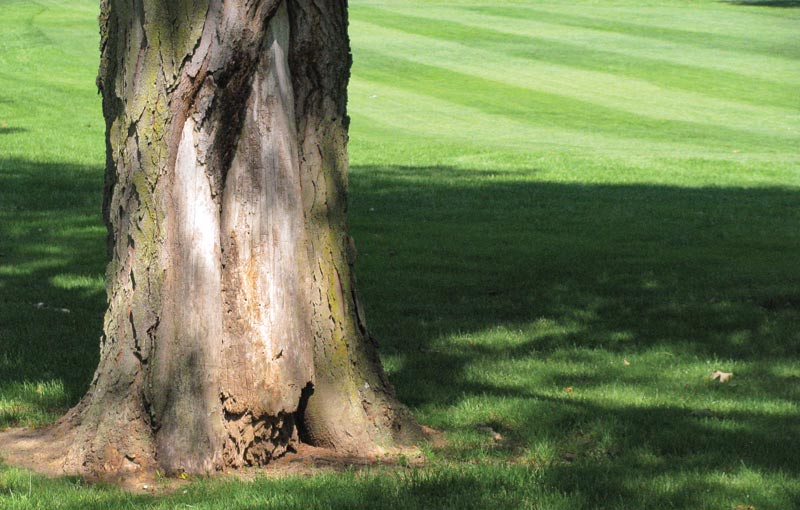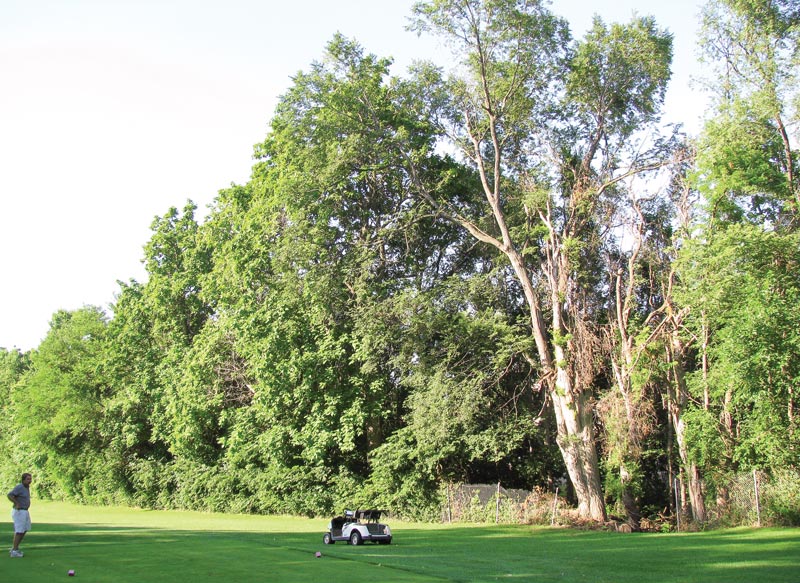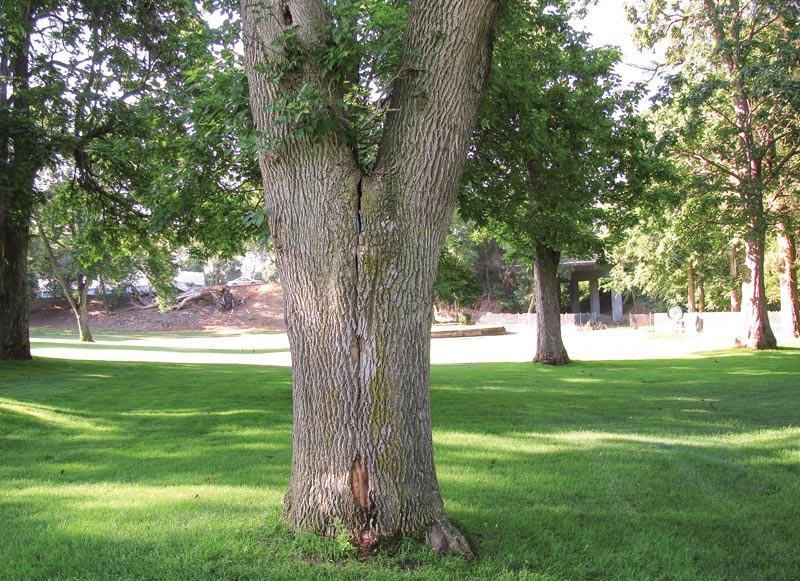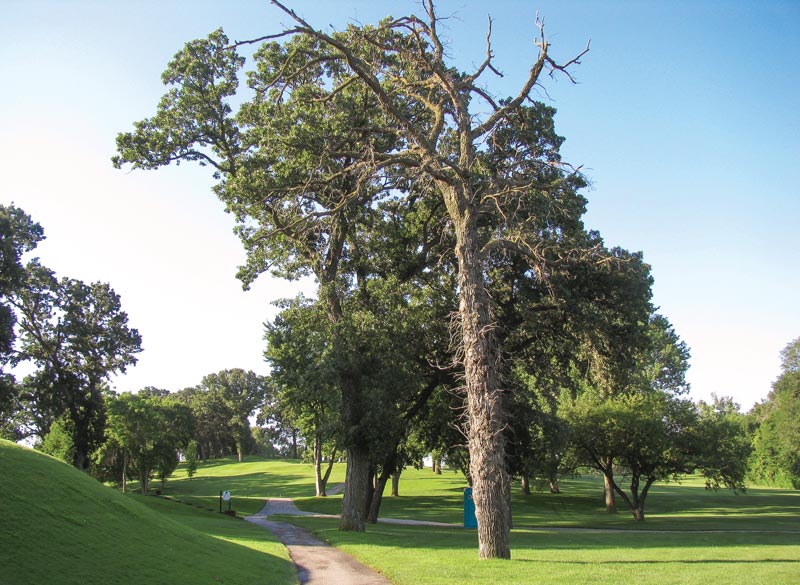
Troubled trees on golf courses, such as this one showing signs of basal root plate damage and heartwood decay, require a superintendent’s attention and, often, need to be removed. Photos by John C. Fech
Sometimes we need to convince others that a certain action is necessary. This is especially true of big, emotional or politically charged actions. Tree removal on golf courses is one of those, on all three fronts.
While there are many approaches to preparing a pitch to decision-makers at your golf facility concerning a tree-removal project, it’s most effective to work it from several angles and to include all pertinent factors, leaving nothing out. As you prepare your pitch, consider the following seven tips.
1. Take ‘raw notes’
This step is great for being inclusive without attaching any judgment to any entry — sort of a brainstorming-on-paper session.
So, what does this look like? You can put raw notes together in several forms. I’ve seen superintendents use a series of rectangular boxes that represented each area they’d like to remove trees from, with room in those boxes for a quick sketch and a few comments. You can use a simple set of lines next to a golf hole layout to illustrate areas of concern. Even a legal pad where you’ve written quick notes during a trip around the course works. The key is to keep whatever you’re doing open-ended and nonjudgmental.
If you need encouragement in this area, just open YouTube and watch an episode of the old television series “Dragnet.” There’s no better way to remind yourself to focus on “just the facts, ma’am.”
2. Consider the pitchee
Giving consideration to the person who will be hearing your proposal before you even go into the room is vital to achieving a positive outcome. A great way to approach this is through the Greek philosopher Aristotle, who divided the means of persuasion or appeals for action into three categories: ethos, pathos and logos.
Ethos
Ethos (credibility), or ethical appeal, ties the process of convincing to highlighting the character of the presenter or author. The reputation of an arboriculture expert would fit here. Calling attention to the person’s credentials, training and experience can be useful in certain situations.
Pathos
Pathos (emotion) is an attempt to evoke an emotional response from the listener. Drawing attention to the harm that may result from a tree falling on an unsuspecting golfer could be emphasized in an emotional appeal. But be careful with emotion, as you may receive resistance for removing certain trees that have historical or memorial value, especially if the pitchee donated them to the course.

Extensive decay and a severely damaged canopy make this tree a good candidate for removal. Any tree near a tee or green should be routinely inspected for pests and structural defects.
Logos
Logos (logic) refers to persuading by using reasoning. Appeals that use an “if A, then B,” an “A-to-B-to-C” or an “in the past, this was the result of ... ” approach are possibilities here. A logical pitch allows for the introduction of specific information, such as projected reduced costs that will result from tree removal.
For example, removing certain trees around a struggling green will increase airflow, which can result in less brown patch and powdery mildew, which means healthier, denser, greener turf, fewer fungicide applications, and less labor cost. Most owners and green committee members understand return on investment, so framing the pitch in those terms can pay dividends.
The reason for including Aristotle and tree removal on golf courses in the same article is that each of us identifies, more or less, with something in each of those three categories, and being intentional about which one you use for a listener is helpful. Doing a little background work on identifying the personality or tendencies of those you’re making the pitch to will help you determine which Aristotelian approach to use.
Again, simple notes or jotted phrases can help guide the pitch for action. After recalling facts and figures and considering the predisposition of the personality of the receiver, the stage is set for strategizing the pitch.
3. What’s the objective?
As you prepare to make your case, ask yourself exactly what it is you’re trying to accomplish. Writing that out often helps, as it refocuses the main purpose of the pitch or project.
Naturally, a pitch can be described in overall or specific terms. Normally, this step is to be more general, such as “remove all historically problematic trees from high traffic areas.” Another might be to “implement an independent inspection of current tree resources on the golf course.” Specific action items should be the second-to-last step of the pitch, just before evaluation of the success of the project.
4. Identify obstacles
So, what’s standing in the way? There could be many “interrupters” or “blockers” that could potentially derail your pitch and your project. Common ones include:
Time and attention
Your decision-maker/green committee/owner probably already has a full plate with deadlines, projects and other people’s issues. They may not want to hear about your plan to remove trees from the golf course.
Initial perception
The tree-removal plan may sound OK to you but really doesn’t fit in with the overall concept of increasing rounds and attracting new members ... or so it would seem at first. Plus, some decision-makers bristle at the notion of removing something that doesn’t appear to them as problematic.

Depending on the tree’s location on the course, this co-dominant leader and vertical crack can create serious condition issues.
Competition
There are other managers/project leaders at your facility — the club pro, the general manager, the food and beverage manager — who want to pitch their ideas for a new project for the course. The tree-removal plan might be fourth in a stack of projects being proposed to your facility’s decision-makers.
Money
It costs money to remove trees and more to plant new ones. How does the stakeholder know that the return on investment is worth it? It’s the superintendent’s responsibility to make that clear.
Too much work, too little focus
Every department at your golf facility has its ongoing projects — it’s likely that your golf maintenance department has other turf improvement projects in the works. Another new one might trigger a response such as, “The last thing we need around here is another project,” or, “Holy cow, you haven’t even finished the Poa reduction on No. 11 green yet.”
5. Make a road map
Figuring out how you’re going to get to the finish line with your tree-removal project should be kept in mind as you develop your proposal and your “pitching points.”
K.I.S.S.
Keep it short, sweetheart. The proposal must be brief — decision-makers of all ages and demographic groups respond best to clear, concise presentations, not small print and run-on verbiage.
Make it visual
Instagram, Pinterest, Twitter, Facebook, YouTube and Snapchat are popular in part because of their ability to instantly paint a picture in the user’s mind. This principle holds true for the purposes of golf course tree removal. A few problematic scenarios (thin turf, algae, encroaching limbs) next to poorly placed or unhealthy trees (cracks, leaning, surface roots) and items that they could fall on can be easily photographed and presented.
Unassailable
The proposal must be without flaw, bulletproof and unassailable. It must not contain projected results based on conjecture or statements such as, “I think that this will happen after we remove these trees.” Be factual and be decisive.
Documentation
Use established, existing documents to support the plan, such as course standards or USGA/GCSAA best management practices. Research results that have been published in GCM are great documentation for supporting tree-removal plans. In other words, align this plan with that one.


Top: Photos of moss and pathogen damage can help decision-makers understand the influence of poorly placed trees. Bottom: The need to remove this tree depends largely on how frequently the nearby cart path is used.
WIIFM (What’s In It For Me?)
Emphasize problem-solving, aka burden relief. Decision-makers always want to know what’s in it for them and the course, even if it costs money to get there. This is where you talk about getting rid of problems A, B and C and obtaining benefit D, E and F by spending a certain amount of time and money.
Sweeten the pot
Always try to add just one more benefit to your proposal. Removing trees from the perimeter of one fairway will have an obvious agronomic benefit, for example, but don’t forget to touch on the strategic and playability benefits from the change. Many stakeholders are interested in or impressed with extras — tangible benefits they get for the same price.
Pre-plan
Anticipate a decision-maker’s objections to the plan and be ready to counter them. Work out and practice your answers with a friend or co-worker in a role-play environment. Know the long run, the short run and a basic step-by-step process, and be able to spout them off without hesitation.
Timing
Timing is everything. Anticipate when the decision-maker will be most receptive to hearing proposals, and deliver the pitch at that time. Perhaps the three days of the month when the owner is paying the biggest bills isn’t the best time for the pitch, but the week after a successful member/guest tournament would be.
6. State the situation
Prepare a three-part situation chart or list (like this example) that can help illustrate different situations around your property. It’s best to divide them into trees where you’ll likely have to accept how things are now; trees where possible action will be needed or trees that you’re watching closely; and trees where action is necessary right away.
This step helps illustrate to the decision-makers that you’re being reasonable and willing to accept that it’s not always feasible to make all the changes that you’d like to make. Plus, it highlights the proposed actions of highest need.
7. What were the results?
All projects call for planning, consideration of options, implementation and evaluation. Tree removal is no different. Six months after the removal of a tree, remembering the problems that it was causing (photographic recall is best) and providing an honest analysis of current conditions will bring the project full circle.
After evaluation, further actions are likely to be required, such as replanting, more tree removal or hardscape installation. Assistance from an ISA-certified arborist, preferably one with Tree Risk Assessment Qualification, is invaluable in revisiting the previously implemented steps and considering recommendations for the future.
John C. Fech is a horticulturist and Extension educator with the University of Nebraska-Lincoln. He is a frequent contributor to GCM.